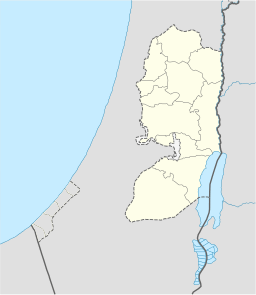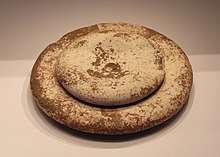Gilgal I
Gilgal I (Hebrew: גלגל) is an archaeological site in the Jordan Valley, West Bank, dated to the Neolithic period. The site is located eight miles north of ancient Jericho.[1] The features and artifacts unearthed at Gilgal I shed important light on agriculture in the Levant.[2]
 Shown within the West Bank | |
| Location | West Bank |
|---|---|
| Coordinates | 32.032778°N 35.475556°E |
| Type | Tell |
| Part of | Village |
| History | |
| Material | Charcoal, seeds |
| Founded | c. 9500-9300 BC |
| Periods | PPNA, PPNB, Neolithic |
| Site notes | |
| Excavation dates | 1979-2005 |
| Archaeologists | Bar-Yosef, O., Noy, T. |
| Condition | Ruins |
| Public access | Yes |

History
Gilgal I was first excavated by Tamar Noy in 1979. Further excavations were conducted by Ofer Bar-Yosef of Harvard University and Mordechai E. Kislev and Anat Hartmann of Bar-Ilan University. They found caches of selectively propagated fig seeds, stored together with wild barley, wild oat, and acorns in quantities too large to be accounted for even by intensive gathering, at strata datable c. 11,000 years ago. The dig also unearthed the remains of thirteen round buildings made of mud and rock.[3]
Some of the plants tried and then abandoned during the Neolithic period in the Ancient Near East, at sites like Gilgal I, were later successfully domesticated in other parts of the world.[4] At Gilgal, archaeologists found ancient carbonized figs stored in an 11,400-year-old house which appear to be a mutant "parthenocarpic" variety, bred for human consumption.[5]
The figs discovered at Gilgal lack embryonic seeds, a mutation that does not survive in nature more than a single generation. This suggests that the fig trees at Gilgal were artificially maintained by planting live branches in the ground, a horticultural technique known as vegetative propagation. Some fig remains recovered from other sites in the Middle East appear to be of the Gilgal variety.[6]
Pre-Pottery Neolithic A (PPNA) baked clay objects were discovered at Gilgal I, most of them figurines and symbolic artifacts. As some of the earliest ceramic findings in the Levant, they are of interest to archaeologists for their artistic, stylistic, symbolic and technological characteristics.[7]
The Moreshet Foundation Israel (MHF Israel) is developing the Gilgal Education Center in the Jordan Valley, a center open to the public that will highlight the importance of this archaeological site.[8]
See also
- Archaeology of Israel
- Gilgal (kibbutz)
- Levantine archaeology
References
- Farming began with fig trees, say experts
- Gilgal: Early Neolithic Occupations in the Lower Jordan Valley (The Excavations of Tamar Noy)
- Where's the historical Gilgal?
- Kislev, Mordechai E.; Hartmann, Anat; Bar-Yosef, Ofer (2006). "Early Domesticated Fig in the Jordan Valley". Science. 312 (5778): 1372–1374. doi:10.1126/science.1125910. PMID 16741119.
- Farming began with fig trees, say experts
- Ancient Fig Find May Push Back Birth of Agriculture
- Technology of the fired clay objects from Gilgal I
- Gilgal Visitors Center
Further reading
- Bar-Yosef, O. Gopher, A. Goring-Morris, A.N., Gilgal: Early Neolithic Occupations in the Lower Jordan Valley, The Excavations of Tamar Noy American School of Prehistoric Research Monograph Series 4Brill Academic Publishers, 2005
- Noy, T., Gilgal I - A Pre-Pottery Neolithic Site Israel - The 1985-1987 Seasons, Paléorient, 15/1, 11-18, 1989
- Noy, T. Kozłowski, S.K., A Basket of Flint Artefacts from House 11 at Gilgal I, Locus 37/42, Kozłowski and Gebel (eds.) 1996, Neolithic Chipped Stone Industries of the Fertile Crescent, and Their Contemporaries in Adjacent Regions, Studies in Early Near Eastern Production, Subsistence and Environment 3, ex oriente, Berlin, 271-288, 1996.
- Noy, T., Stone Cup-Holes and Querns from Gilgal 1: a Pre Pottery Neolithic A Site in Israel, Paléorient, 5, 1979